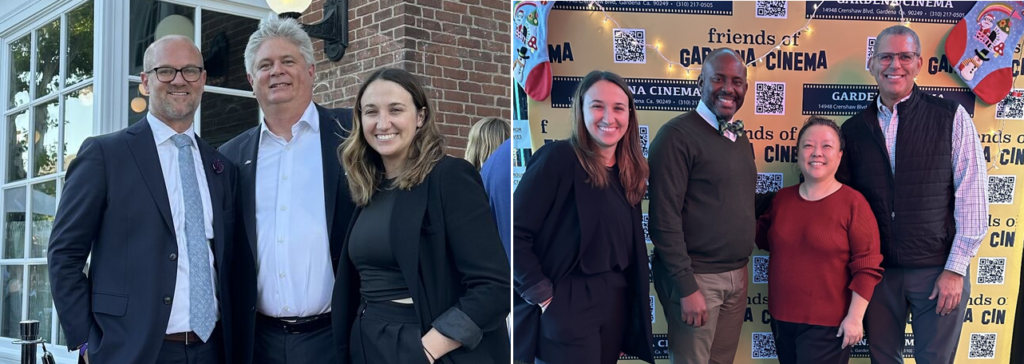
Amanda Martin brings a distinctive background to her role as the National Association of Theatre Owners’ Chief of Staff, including experience in the video game industry and the U.S. Congress. Martin previously worked with Michael O’Leary, NATO president and CEO, at the Entertainment Software Association (ESA). Before her time at the ESA, she worked as district staff for Eric Swalwell, a California congressman. Martin’s familial ties to the movie theatre industry have provided a meaningful connection to her work at NATO, marking a significant chapter in her professional journey.
What are your core responsibilities as chief of staff at NATO?
My biggest responsibility is helping to manage the strategic and operational direction of NATO. I work closely with all of the great people at NATO and theatre owners on various issues. An important example is our three-year strategic plan. I work closely with the NATO Strategic Planning Committee, NATO members, and NATO staff to implement the plan. I have projects that I am responsible for, but I am also here to support and help everyone at NATO to be successful. I also work closely with Michael as a sounding board to help him focus on the organization’s priorities.
What specific initiatives are you working on that you are excited about?
We are always focused on providing value to our members. This year, we launched a webinar series to promptly educate our members on important issues. It’s an ever-evolving project where the NATO team identifies meaningful topics, puts together panels, and executes the webinar. This has been a fun and rewarding effort that directly benefits our members.
You came to exhibition from the video game industry. Did you take anything from your time in video games that has helped you in this industry?
My biggest takeaway from the video game industry is their commitment to innovation. Video games are a relatively new form of entertainment, but I was amazed at how many companies don’t just view their video games as entertainment. They use them in education, military training, medical training, and even disease treatment. That innovative thinking and use of entertainment in nontraditional ways to help people is something I like to explore with my approach to exhibition.
You led the effort to create the “Behind the Screens: Faces of Exhibition” video series that was a hit at CinemaCon. What did you learn from that process?
“Behind the Screens” was an amazing project to work on. The process showed me the power of telling our members’ stories and that our members’ stories resonate and inspire people outside of exhibition. I think of Emelyn Stuart, who initially got into exhibition because she wanted a place to see the stories she cared about. How many people across the country and globally can be inspired by and relate to going out and filling a gap in their community? Or Shankweiler’s Drive-in, where Lauren McChesney and Matt McClanahan saw that a drive-in they loved would be sold to a developer. They didn’t want to lose that important cultural hub for their community, so they bought and now operate that theatre. As an advocate, I talk about theatres’ cultural and economic impact, but the stories in these videos make it real, and people responded positively to them.
When you look to the future, what is the most important thing NATO can do for exhibition?
One of the core things any successful trade association must do is prioritize education for its members, making them aware of trends, new technologies, and innovations by other exhibitors and outside industries. We launched the webinar series, the ITOC calls, education at CinemaCon, and the Fall Summit as a way for NATO to help our members look forward. Everything we do should help our members succeed in the marketplace.
In your capacity, you work with many NATO members of all sizes and from different places around the world. What is your biggest takeaway from the theatre owners you talk with?
The greatest joy I have in interacting with members of all sizes is seeing their passion for the industry and the theatrical experience. Our members from big cities, small towns, and across the globe are always innovating and looking to elevate the experience for moviegoers. They are also willing to jump in and volunteer to help—not just the NATO staff but their fellow members—and it has been a driving force behind the work we do here at NATO.
In addition to being chief of staff, you are also a government affairs advocate for exhibition at the state and federal level. Tell us about that. Is it something you enjoy?
I have always had an interest and passion for politics, for better or for worse, so scratching that advocacy itch on the state and federal level has been fun. I was eighth-grade class president, ran a political club in college, worked on campaigns, and worked for my local congressional member, so it is nice I have been able to do this throughout my career. The political nerd in me still gets excited to go up to Capitol Hill and talk with congressional staffers.
You worked for a member of Congress, in the video game industry, and now in exhibition. Was there a point in your career or background when you thought you might work in the movie industry?
I never thought I would work in the movie industry, but it became a full-circle moment for me and my family. rom the ‘60s to the ‘90s, my grandpa Ralph L. Martin and family owned several movie theatres and drive-ins in California, mostly in the Bay Area and Central California, and many were devoted to Spanish language movies. They ran the gamut. My grandpa worked at his first theatre in Mountain View, California, with his uncle in the 1930s. Later on, he owned theatres with former NATO Chair Phil Harris, and with longtime family friend, NATO member Jerry Harrah.
